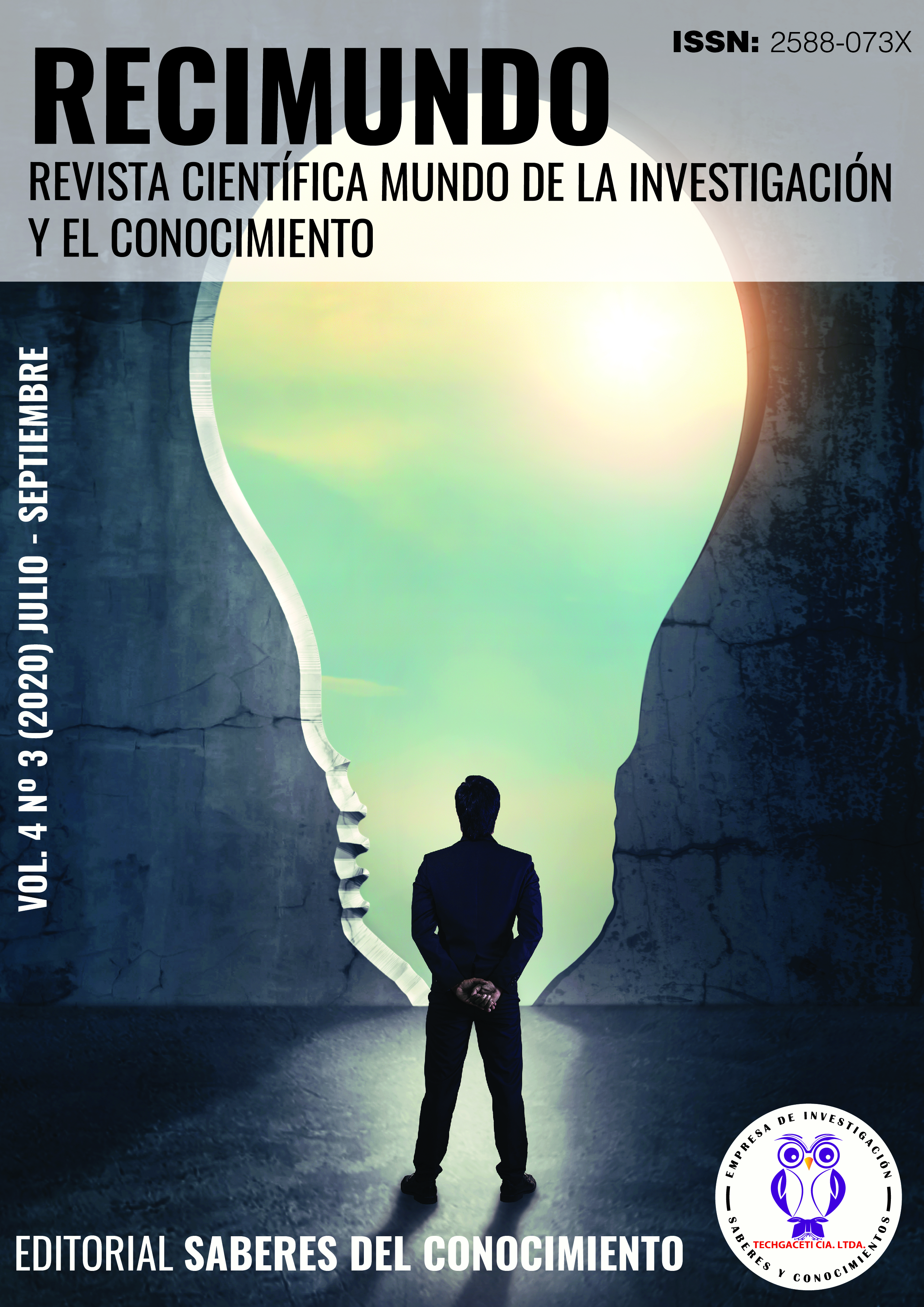Hematoma subdural crónico: tratamiento
DOI:
https://doi.org/10.26820/recimundo/4.(3).julio.2020.184-198Palabras clave:
Hematoma subdural crónico, hematoma subdural intracraneal, procedimiento quirúrgico, hematoma subduralResumen
El hematoma subdural crónico (CSDH por sus siglas en inglés) es una de las afecciones neuroquirúrgicas más comunes. Hay falta de uniformidad en el tratamiento de la CSDH entre los cirujanos en términos de diversas estrategias de tratamiento. La presentación clínica puede variar de ningún síntoma a la inconsciencia. La CSDH generalmente se diagnostica Tomografía computarizada mejorada por contraste. La exploración por resonancia magnética (MRI) es más sensible en el diagnóstico de CSDH isodensa bilateral, floculaciones múltiples, membranas intrahematoma, sangrado reciente, hemólisis y el tamaño de la cápsula. La TC de contraste o RM mejorada podría detectar enfermedades dúrales primarias o metastásicas asociadas. Aunque en la mayoría de los casos se puede obtener un historial definitivo de trauma, algunos casos pueden ser secundarios a un defecto de coagulación, hipotensión intracraneal, uso de anticoagulantes y fármacos antiplaquetarios, etc., sangrado recurrente, aumento de exudados de la membrana externa y atrapamiento de líquido cefalorraquídeo. estado implicado en la ampliación de CSDH. La evacuación de rebabas es el tratamiento de elección para una CSDH sin complicaciones. La mayoría de los ensayos recientes favorecen el uso de drenaje para reducir la tasa de recurrencia. La craneotomía y la craneotomía con broca helicoidal también juegan un papel en el manejo. Se debe tomar una biopsia DURAL, especialmente en recurrencia y membrana externa gruesa. El tratamiento no quirúrgico está reservado para pacientes asintomáticos o de alto riesgo quirúrgico. Los esteroides y los inhibidores de la enzima convertidora de angiotensina también pueden desempeñar un papel en el tratamiento. La estrategia de gestión única no es apropiada para todos los casos de CSDH. Una mejor comprensión de la naturaleza de la patología, la selección racional de una estrategia de tratamiento ideal para un paciente individual y la identificación de los méritos y limitaciones de las diferentes técnicas quirúrgicas podrían ayudar a mejorar el pronóstico.Descargas
Citas
Abouzari, M., Rashidi, A., & Rezaii, J. (2007). The role of postoperative patient posture in the recurrence of traumatic chronic subdural hematoma after burr hole surgery. Neurosurgery, 794 7.
Battaglia, F., Lubrano, V., & Ribeiro Filho, T. (2012). Incidence and clinical impact of seizures after surgery for chronic subdural haematoma. Neurochirurgie, 230 4.
Bolívar, J. (2015). Investigación Documental. México. Pax.
Castro, J. (2016). Técnicas Documentales. México. Limusa.
Davila, A. (2015). Diccionario de Términos Científicos. . Caracas: Editorial Oasis.
Domenicucci, M., & Russo, N. (2009). Relationship between supratentorial arachnoid cyst and chronic subdural hematoma: Neuroradiological evidence and surgical treatment. J Neurosurg, 1250 5.
Ducruet, A., Grobelny, B., & Zacharia, B. (2012). The surgical management of chronic subdural hematoma. Neurosurg Rev, 155 69.
Escosa Baé, M., Wessling, H., & Salca, H. (2011). Use of twist drill craniostomy with drain in evacuation of chronic subdural hematomas: Independent predictors of recurrence. Acta Neurochir (Wien), 1097 103.
Feng, J., Jiang, J., & Bao, Y. (2008). Traumatic subdural effusion evolves into chronic subdural hematoma: Two stages of the same inflammatory reaction? . Med Hypotheses, 1147 9.
Galaznik, J. (2011). A case for an in utero etiology of chronic SDH/effusions of infancy. J Perinatol, 220 2.
Janowski, M., & Kunert, P. (2012). Intravenous fluid administration may improve post operative course of patients with chronic subdural hematoma: A retrospective study. PLoS One.
Jobse, I., & Feitsma, M. (2011). Presentation of chronic subdural hematoma in the elderly. Tijdschr Gerontol Geriatr, 139 43.
Kim, B., Lee, K., & Shim, J. (2010). What determines the laterality of the chronic subdural hematoma? J Korean Neurosurg Soc, 424 7.
Krupa, M. (2009). Chronic subdural hematoma: A review of the literature. Ann Acad Med Stetin, 47 52.
McClelland, S., Won, E., & Lam, C. (2017). Utilization of recombinant activated factor VII for intracranial hematoma evacuation in coagulopathic nonhemophilic neurosurgical patients with normal international normalized ratios. Neurocrit Care, 136 9.
Mishra, A., Ojha, B., Chandra, A., & Srivastava, C. (2011). Giant unusual shaped chronic subdural hematoma in a patient with untreated congenital hydrocephalus. Asian J Neurosurg, 121 2.
Miyagami, M., & Kagawa, Y. (2009). Effectiveness of Kampo medicine Gorei San for chronic subdural hematoma. No Shinkei Geka, 765 70.
Mondorf, Y., Abu Owaimer, M., & Gaab, M. (2009). Chronic subdural hematoma: Craniotomy versus burr hole trepanation. Br J Neurosurg, 612 6.
Park, S., Kang, D., & Park, J. (2014). Fibrinogen and D dimer analysis of chronic subdural hematomas and computed tomography findings: A prospective study. Clin Neurol.
Park, S., Lee, S., Park, J., & Hwang, J. (2008). Chronic subdural hematoma preceded by traumatic subdural hygroma. J Clin Neurosci, 868 72.
Santarius, T., Lawton, R., Kirkpatrick, P., & Hutchinson, P. (2008). The management of primary chronic subdural haematoma: A questionnaire survey of practice in the United Kingdom and the Republic of Ireland. Br J Neurosurg, 529 34.
Sucu, H., Gökmen, M., & Ergin, A. (2007). Is there a way to avoid surgical complications of twist drill craniostomy for evacuation of a chronic subdural hematoma? . Acta Neurochir (Wien), 597 9.
Tekin, T., Colak, A., & Kutlay, M. (2012). Chronic subdural hematoma after endoscopic third ventriculostomy: A case report and literature review. Turk Neurosurg, 119 22.
Wester, K., & Helland, C. (2008). How often do chronic extra cerebral haematomas occur in patients with intracranial arachnoid cysts? J Neurol Neurosurg Psychiatry, 72 5.
Zakaraia, A., Adnan, J., & Haspani, M. (2008). Outcome of 2 different types of operative techniques practiced for chronic subdural hematoma in Malaysia: An analysis. Surg Neurol, 608 15.
Zhao, K., Zhang, R., & Sun, Q. (2010). Comparisons of 2/3Sh estimation technique to computer assisted planimetric analysis in epidural, subdural and intracerebral hematomas. Neurol Res, 910 917.



